How Can I Find Where My Septic Tank Is Located
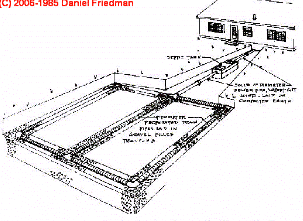 How to Find The Septic Tank
How to Find The Septic Tank
Step by step how to locate septic tanks for inspection or septic tank pumping
- Mail service a QUESTION or Comment nigh all methods for locating a septic tank, drywell, or cesspool as well as other septic system components such every bit the D-box and septic soakaway bed, leaching field, or drainfield.
InspectAPedia tolerates no conflicts of interest. We accept no relationship with advertisers, products, or services discussed at this website.
Septic tank location guide:
This document provides suggestions and procedures for finding a septic tank.
This very detailed article series (see links listed at the ARTICLE INDEX the bottom of this article or below) tells how to locate a septic tank or other buried site components such as the distribution box, drainfield, or a cesspool or drywell when it'south placement is not already known or when the location of the septic tank is non visually obvious.
This guide explains the septic tank search procedure and lists sources of information about septic tank location. We describe who may know where buried components are located at the site, how to inspect the site, and what mistakes to watch for in assuming that the information yous see, read, or are told is absolutely correct.
We also provide an ARTICLE Index for this topic, or y'all tin can try the page top or lesser SEARCH BOX as a quick way to notice information you need.
How to Discover the Septic Tank, Cesspool, Drywell, D-box, or Drainfield
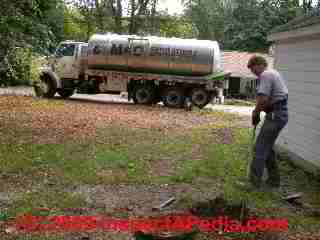
Offset here and in a series of detailed procedures we explain diverse methods to locate cached onsite wastewater disposal system components: the sewer line or main drain, septic tank, septic tank cleanout openings, distribution box, septic drainfield, and related site components.
If you prefer to sentinel a video on how we figure out where a septic tank could or could not be located,
run across SEPTIC VIDEOS.
Also see SEPTIC DRAINFIELD LOCATION.
When the septic tank needs to be pumped, a regular maintenance job, the cost of that service will be less if the belongings owner found the septic tank location and mayhap even uncovered the septic tank pumping admission cover.
Other reasons to observe the septic tank include inspecting and testing septic systems when buying a dwelling house or for safety, to assure that the septic tank embrace is in practiced condition.
If you don't know whether your holding even has a septic tank, your building could be connected to a municipal sewer primary. To figure this out,
see SEPTIC or SEWER CONNECTION?
Safety Warnings for People Looking for the Septic Tank
Watch Out: Septic System Warnings: Hither are a few weather that may exist disruptive or unsafe and which you should go on in listen:
- Beware of old, collapsing septic systems
falling into a cesspool or septic tank is probable to be fatal. Sentry out for testify of subsidence or sinking soil, rusted-through steel septic tank covers, home-made wooden or flimsy tank covers, or dwelling house fabricated cesspools and drywells which take chances collapse.
Dig or probe with great care and do not piece of work solitary. More guidance virtually safety when working on or around septic systems can be read
at SEPTIC & CESSPOOL Prophylactic. [Thanks to Donica Ben for reminding united states that in that location are other potential hazards such every bit striking a buried electrical wire.]
- Multiple main drains?
At a large holding or a holding with plumbing fixtures at widely separated portions of a building, the builder may have constructed more than than one septic system, or waste lines could get out the edifice from more than ane location even if they go to the same septic system.
This would be uncommon in a modern habitation. But at a property which has been expanded, say to add an apartment at a far end from where all of the other building plumbing exists, this is a possibility to keep in mind.
Consider the age of the building, the complexity of its layout, and the history of additions of baths or kitchens at widely separated areas as a inkling suggesting that more ane septic organization or waste line may be present.
- Separate drywells?
On backdrop which accept septic bleed fields (absorption systems) of limited capacity to blot wastewater, or for reasons of simple convenience in running drain lines, the edifice gray water from laundry or fifty-fifty sinks and showers may be connected to a carve up drywell which is not part of the main septic arrangement.
In the photograph above showing a washing car in the foreground and the main house waste line in the basement left corner in the background, you might wonder if the washer is continued to a carve up drywell. The washing machine in the photo is obviously below the level at which the main drain leaves the firm in the distance. What simplifies finding the septic tank in the instance of this photo is that in that location is only 1 large diameter waste matter drain leaving the business firm.
- Master drains are bigger
The master house drain lines will be comparatively large in diameter, a minimum of 4" (obsolete) and maybe 6" in bore. Individual sink or shower drains may be i.5" or ii" in diameter. So if you can see exposed plumbing, just discover the area beneath a building toilet and follow that bleed.
Toilets must exist continued to a septic system, even if other building fixtures connect to a separate drywell. Right now nosotros're looking for the septic tank, not a drywell.
Ask Those Who May Already Know the Septic Tank Location
Ask the prior owner: the Building'due south Most Contempo Owner May Know the Septic Tank Location
When the location of a septic tank is not visually obvious enquire the building'southward most-recent owner the location of the septic tank. But beware, people can exist mistaken, or may take forgotten, or may accept never known where their septic tank is buried.
When a building owner does not know where the septic tank is located that is itself useful information. In that case, if we know how long the owner has been in the building, we know it has probably been been at least that long since the septic tank was last pumped.
When a septic tank has not been pumped on schedulethen even before inspecting the system we must be more pessimistic about the status of the arrangement and in particular, nigh the remaining life of the drainfield.
An building owner who has had the septic tank cleaned before is likely to know simply where it is located. In an older home an owner may have a drawing of the tank location or may have drawn measurements to the septic tank on a garage or basement wall, mayhap near the chief waste material line outlet.
Watch out: sometimes the a building possessor or prior owner does not actually know the tank location, may accept forgotten, or have go dislocated. We conducted a big excavation at the spot where a homeowner told us, with great confidence, where a buried component was located. Ultimately we discovered the component more than 50 feet abroad.
When we confronted the owner with this confusing data he remembered and explained: "Yep, I never actually saw it, that'due south where the previous owner told me he thought information technology was."
Run into details at VISUAL CLUES LOCATE the SEPTIC TANK
and
details at SEPTIC TANK PUMPING SCHEDULE
Ask local septic tank pumping companies for help: local septic servicers may know tank location
In addition to asking building owners, if the historic period of the home ways that the septic organization has been present for four years or more, it is possible that even though a current owner may not know the septic tank location, a local septic pumping company might.
It's worth a telephone call to each local septic pumper to ask if they've serviced the property. WARNING: don't rush to permit a service company or local excavator come out to dig up the thousand - information technology may not be necessary and it may involve unnecessary costs.
Look For Records of Septic Tank Location
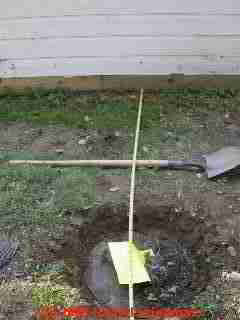
Nigh often homeowners who have ever had a septic tank installed or serviced record a sketch showing measurements to the septic tank from some visible property feature such every bit a corner of the building.
At Tape SEPTIC TANK LOCATION we depict the procedure for making those measurements and the required sketch.
Wait in the building basement or crawl infinite for the bespeak at which the chief building bleed exits the building.
See Discover MAIN Waste matter LINE Leave - starting time finding the septic tank by finding where the waste line exits the building for details.
While a septic drain line tin plough effectually on a holding and the management of the get out drain pipe is non a guarantee, often it points right to a septic tank that is close to the building.
Look in this aforementioned area in the building for a sketch, sometimes drawn correct on the building wall or rim-joist, marking distances to the septic tank and its cleanout cover.
Meet SEPTIC TANK LOCATION SKETCH - how to make a sketch showing a septic tank, D-box, or drainfield location
Cheque with local septic tank service companies. If the building is not new, it is possible (we wish we could say likely) that prior owners had the septic tank cleaned or repaired from time to time. If so the visitor may take notes on where the tank is located.
Simply Where to Look for The Septic Tank
Unknown septic tank location process: This article tells united states of america how to locate a septic tank when information technology's placement is not already known or when the location of the septic tank is non visually obvious. We include instance photographs from across the U.S. and from other countries illustrating visual clues for finding a septic tank when its location is unknown.
When a septic tank needs to exist pumped, a regular maintenance chore, the cost of that service will be less if the property owner constitute the septic tank location and perhaps fifty-fifty uncovered the septic tank pumping access embrace.
Other reasons to notice the septic tank include inspecting and testing septic systems when buying a dwelling or for safety, to assure that the septic tank comprehend is in adept condition.

Videos showing how to discover the septic system, septic tank, & septic drainfield are
at SEPTIC VIDEOS.
Besides see SEPTIC DRAINFIELD LOCATION - how to find the leach fields.
- Find the main building drain exit bespeak. Oftentimes the septic tank is x feet away in a direct line from that point. (Not ever). Our photograph (left) shows a wall vent continued to the principal building bleed line (too shut to a window too). We looked for the septic tank in a straight line away from the firm starting in this location.
Start looking close to the house wall - mayhap 4 ft. abroad (which would be too shut for modern standards) or at 10 feet abroad for a better location.
Septic tanks are often buried close to a building because of the convenience of excavation during original construction, and to avert unnecessary piping costs to a remote tank.
On occasion, peculiarly in an un-finished basement or clamber surface area, you lot may find a septic locating sketch on newspaper, folded and stuffed nearby, or a sketch drawn right on the building foundation wall or rim joist.
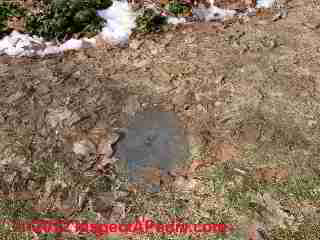
Building codes typically require that the tank be located 10' or more from the edifice and so 4' is a chip close just at some erstwhile properties we've found the septic tank correct next to the foundation wall of the house.
At 12 feet from the home nosotros constitute this flat stone in the lawn, marking the septic tank cleanout opening.
Lookout man out: the septic tank may nevertheless be located distant from a building if site weather such every bit space, rock, proximity to a well or lake prevent its installation nearby.
Our photo (beneath left) shows where we spotted a septic arrangement cover downhill from a hilltop restaurant in Molde, Norway. The urban center, Molde, is visible in the upper portion of the photo.

- Look downhill from the building main drain if in that location is no septic pump system installed.
- Expect at the site itself for obstructions that might have forced the excavator to put the tank into a more remote location, such as large rocks and boulders, streams, holding boundaries, wells, similar site features.
- Expect for subsidence in a round or rectangular pattern that may mark the septic tank location.
- Expect for bald spots where at that place is no grass growth or brown grass that's stale out - - marker a shallow-buried septic tank top
- Look for greenish grass that may mark a septic tank that is backing up and leaking.
Encounter SEPTIC TANK GRASS

- The location of this septic tank was downhill from a dwelling located shut to a lake in Grand Marais in northern Minnesota.
If you are looking for septic arrangement components at a edifice close to a lake or other waterway, the tank may be downhill from the building so that the building does not have to pump wastewater to the septic tank.
But await to discover a pumping chamber at the septic tank that sends effluent to a drainfield that will exist located uphill and well away from the waterway.
That electrical box sticking up in the thou pointed out the pumping station for this septic tank, and the rectangular growth over the tank was a rather compelling clue every bit well.
A septic tank cleanout and pumping station access covers were located within that growth.
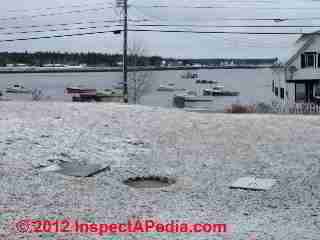
- If there is snow-cover look for a round or rectangular surface area of thinner snow or melted snow; bacterial action and warm wastewater often mean a college temperature at the septic tank.
Details are at SEPTIC TANK SNOWMELT.
Our photo (above-left) illustrates melting of light snow encompass to a higher place septic tank access covers at a property in northern Maine.
- In the photo at page summit nosotros saw a very rocky hill with thin soil, making the likely septic tank location downward in the distant, flat, lower yard.
The septic tank was constitute to the left of the garage simply at the bottom of the hill. The small size of the available area also means that the owner chose to install a pair of loftier capacity drywells to absorb septic effluent instead of a more than space-hungry conventional drainfield.
- Look for a 6" or 8" septic cleanout or access piping such as the one shown in our photograph . This septic system is located in Marana, outside Tucson, Arizona. The terrain is not only hot and arid, only as well flat - non much worry about having to look "downhill" from the edifice.

- OurSEPTIC VIDEOS show how you can walk a belongings to observe areas that are probable or unlikely to contain the septic tank or drainfield. Locations such equally dense mature trees shut together, or right next to a drinking water well are not where we'd expect to find the septic tank.
Exploratory Digging to Find the Septic Tank
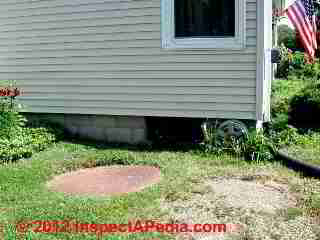
Our photograph shows a round steel septic tank cover right at basis level and merely about 30 inches from the house foundation wall. You can see that if you lot were jamming a probe into the soil over a cover like this one, you lot'd easily puncture and ruin it.
(When this septic tank rusts through you may see sewage leaking into the building through the foundation wall.)
Dig or probe very gently in the area where you call back the tank cover is located -
Sentry out: beware of collapsing tank covers and do non piece of work alone - falling in is likely to be fatal - read my Safety Suggestions commodity higher up before beginning this work.
What to do if We Tin't Find the Septic Tank?
What if there are no visual clues of tank location and we tin can't easily find it outside?
The last resort is a bigger excavation project which we depict next.
Cross Trenching: At the building wall where the waste line exits, dig a small-scale trench beyond the suspected piping location going down until you find the pipe. Annotation its apparent direction. Move out 3-4 ft. in that direction and dig once more.
In other words, follow the piping past excavating pocket-sized test trenches across the suspected pipe management until it leads you to the tank. This is what an excavator does with a backhoe if they tin't observe the tank by other means.
Tanks may be afar: Beware, while the septic tank is often found close to the edifice (where it'southward easier to bury the tank and for other technical reasons), site conditions tin can make information technology necessary to locate a tank at quite a distance away.
How to Use a Simple Plumbing Snake or Using Electronic Equipment to Find the Septic Tank
Special equipment using a plumbing ophidian and electronic sensors and other methods are available when needed.
By inserting the plumbing snake into the master building bleed and pushing it until it stops dead, the snake stop has usually hit the septic tank inlet baffle. From this process we know the maximum altitude from the building bleed to the septic tank. We say maximum distance considering we don't know for certain that the bleed line runs straight to the tank.
A combination of conductive metal snake in the plumbing drain and electronic equipment tin can trace the routing of a bleed line precisely every bit well as locating the inlet to the septic tank. Details are
at SEPTIC TANK LOCATING EQUIPMENT - plumbing snakes, electronic pipe tracing equipment, etc.
Watch out: well not always precisely. Radio transmitter and similar electronic devices that are used to pinpoint buried pipes can be thrown off a chip if there are other metal pipes buried nearby, crossing or in parallel to the pipeline of interest.
Metallic septic tanks can be institute at their cached location using a metal detector.
When & How to Dig or Excavate to Find the Septic Tank
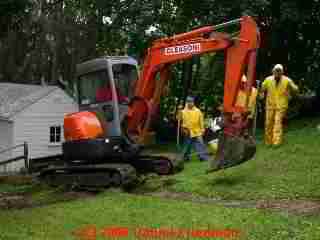
The photo shows excavation during septic system repairs - this is non the best style to observe a septic tank. Knowing the septic tank location can avoid tank damage during repair work, and information technology will save on septic tank pumping cost since you won't be paying an excavator to find and expose the tank cover.
Avoid "finding" the septic tank past using a backhoe unless the operator is very skilled and careful. At our kickoff habitation with a septic tank the backhoe operator "found" the septic tank by driving over it and crushing it, leading to a costly repair.
If you have to excavate, or if you are excavating to confirm the septic tank location and to notice its cleanout covers then heed this alarm:
Sentry out: for unsafe septic tank covers that can collapse - falling into a septic tank is usually fatal. Don't use a heavy iron wrecking bar to "probe" for the septic tank by jamming information technology aggressively into the soil.
That'southward a good way to punch a hole in a steel septic tank chapeau, cause a tank comprehend to collapse,or to outburst a buried piping or intermission a toe.
See SEPTIC TANK COVERS - important prophylactic concerns.
Also run into SEPTIC TANK DEPTH - how deep might the septic tank be buried anyway?
How We Walk the Site to Recognize Where a Septic Tank Could or Would Not be Located
If no record of the septic tank location is at hand, an experienced septic pumper can mostly guess where the tank is likely to be by inspection of the property, or s/he tin can locate the tank by careful probing. Details are
at WHERE TO Look for the SEPTIC TANK - what are the reasonable locations where we could expect for a septic tank
then
at VISUAL CLUES LOCATE the SEPTIC TANK - what can nosotros see that tells us septic tank locatio. A summary is beneath:
We do not usually expect to find a septic tank located:
- At a great distance from the building - such locations involve extra cost that people want to avoid
- Correct side by side to or close to the well - such locations are unsanitary and illegal
See details at CLEARANCE DISTANCES, SEPTIC Arrangement
- On top of visible solid rock or rock outcroppings or where soil is very thin over rock or shale
- At or close to the edges of the property -
run across DISTANCE TO SEPTIC TANK - what are the clearance distances required betwixt a septic tank and other things?
- In the midst of a dense growth of mature copse - how would the backhoe accept gotten in in that location to dig a hole for the septic tank
- Downhill from the probable or credible drainfield location - only a common exceptions include septic tanks that use an effluent pump system to elevator effluent to a mound or raised bed septic organisation, or septic tanks that are located shut to but downwards hill from a edifice close to a lake or stream.
Such installations may identify the septic tank downhill from the building so that building drainage does not require a sewage pump; but in social club to get the septic drainfield an acceptable distance from the lake or waterway the system may have included an effluent pumping station: then the tank is downhill but the drainfield may be uphill from the position of the building itself.
We often expect to notice a septic tank located
- Inside 10-xx anxiety from the building. During building construction information technology is often user-friendly to excavate for both the foundation and the septic tank hole at the same fourth dimension. And keeping the tank close (but not too close) to the structure saves on plumbing costs.
- Also see POSSIBLE SEPTIC TANK LOCATIONS - finding a septic tank includes ruling in and out where it might be
When the septic tank has been located, annotation if it is installed with improper clearances from other site features such as a private well, and inform the owner accordingly. The measurement process to record the septic tank cleanout cover location is
at RECORD SEPTIC TANK LOCATION
Reader Q&A - likewise come across the FAQs series linked-to below
It would be no surprise to notice an abandoned septic tank on a very old property.
Watch out: The existent Hazard is that the cover is on condom and someone Falls in and, depend on what'south in the septic tank face is a quick and nasty expiry. Rubber matter is to fill information technology
And so yeah. I live in a business firm that is over a hundred years former. We started having some problems with continuing water in the lawn a few weeks ago and just recently started to investigate.
Both my neighbor and my dad thought we were hooked upwardly completely to the chief sewer organisation of the town but when we dug into the footing of the backyard we came across a concrete structure to which simply our kitchen sink drains. It seems as though the side of the concrete structure had degraded creating a pigsty through which this nasty smelling h2o is coming out of.
Is it possible that the mystery concrete construction is a septic tank?
Our plan is to uncover the balance of the structure to find the extent of its size and to cutting downwards labor costs from the plumber ;)
Alicia
That could exist a round septic tank access cover. I can't say in function because we know nothing nearly your holding, site, age, history, plumbing, nor the sie of the rock-like item in your photo (It doesn't expect prefectly-round but it may exist tipped)
Scout out: it sits beveled, may be leaking into the septic tank (risking flooding), and worst, if it is not secure over the septic tank elevation there could be a risk of it moving, tipping, and someone stepping into or falling into the septic tank - a quick fatal outcome. It needs to be investigated farther by an experienced excavator or septic contractor.
Hello. Is this photo a septic tank cover? It is up a hill from my house at a skilful distance from the firm. Otherwise, I fear my septic tank may be underneath my concrete patio.

electronic mail to roseh@nc.rr.com
Belinda
Yes it certainly possible that you have found your septic tank.
Picket out: if the condition of the septic tank including its materials of construction and the condition of the cover or whatever admission openings are unknown there is the risk filter encompass is unsafe.
Should someone step through or fall through the risk is Serious injury or even a fatality. Therefore it would be smart to keep abroad from the suspected septic tank location until you have had an excavator betrayal enough of it to understand whst us there, and its condition.
Watch out: also for a septic failure that is likely if your septic arrangement is ane in which no i knew the location of the septic tank.
When no one knows where the septic tank is located to me that suggests that no one has been doing the required regular maintenance of pumping the septic tank. When we never pump the septic tank we shorten the life of the drainfield.
I wanted to institute flowers exterior my bedchamber window, I stuck my shovel in the ground and hit a solid object only six inches down. Using a probe it appears to be appr. 4x5 ft lrg and only ten feet away from original dwelling house and 4 ft abroad from the improver. Septic??
Certainly, Brian, specially in older towns.
In fact nosotros have inspected homes in areas where in that location is municipal sewer but found cases in which
- the home was never connected to the sewer and nonetheless is on individual septic
and also cases in which
- the home had a septic, was after continued to sewer, but the septic tank was left in place and not properly abandoned - this forming a rubber take chances
I have city sewer, is it possible to have an one-time septic on my property still? There is a heavy thick circular piece concrete in the middle of my back yard and I don't know what it is.
Question: does this concrete affair mean we have a septic tank?
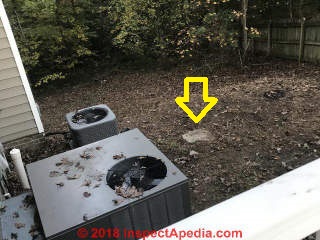
2018/11/04 Jenna said:
Kickoff, please excuse my ignorance. At present .We are considering the purchase of a new dwelling
BUT I am completely confused/concerned with the sewer/septic situation. The habitation is owned by a visitor and the disclosure is basically worthless.
There are ii "covers" on the side of the house. Ane, concrete, I assumed was a septic? The other looks like a sewer manhole cover. The neighbors home besides has the metal "manhole" cover.
So I guess my questions are...does this dwelling house have a septic organisation? Or is it continued to a city system? Isn't this rather shut to the house if it is a septic tank?
If not...why does this house and the neighbors (presumably all) have a manhole access in the yard? And are there whatsoever precautions/inspections/advice we need before proceeding with this house? Cheers!
Reply:
Jenna thank y'all for asking about how to figure out if a dwelling is connected to public sewer or private septic - it'due south not an ignorant question; the just ignorant step would exist failing to ask.
SEPTIC or SEWER CONNECTION?
will help you figure out the answer.
A telephone call to your metropolis's building or water or sewer department can sometimes close the question immediately: inquire if there is public sewer available to homes on your street.
Beyond that:
The square physical on the ground in your photograph looks similar a septic tank access port and marks a mutual and reasonable location for a septic tank near you lot rhome - only could be something else. It is common for a septic tank to be close to the house, perhaps 10 anxiety from the foundation.
It should be trivial to simply lift the comprehend to see what it locates.
If you lot see into a pool of sewage you know it'south a septic tank.
But
Watch out: at any unknown property where there may be a septic tank of unknown condition there'southward a take a chance of falling into a tank or even being overcome by fumes.
Never work lonely, and never lean over the septic opening, nor stride onto a questionable tank cover.
...
Continue reading Altitude TO SEPTIC TANK if you are looking for its location, or select a topic from the closely-related articles below, or see the complete ARTICLE Index.
Or see SEPTIC TANK LOCATION FAQs questions & answers posted originally at this article
Or see these
Recommended Articles
- DISTANCE TO SEPTIC TANK - what are the clearance distances required between a septic tank and other things?
- Dwelling BUYERS GUIDE to SEPTIC SYSTEMS
- HOME SELLERS GUIDE TO SEPTIC SYSTEMS
- HOW TO OPEN a SEPTIC TANK if you accept found the septic tank an dare inspecting or servicing the septic tank
- POSSIBLE SEPTIC TANK LOCATIONS - finding a septic tank includes ruling in and out where it might be
- SEPTIC COMPONENT LOCATION VIDEOS watch a video on how we figure out where a septic tank could or could not be located
- SEPTIC D-BOX LOCATION - discover the Distribution Box
- SEPTIC DRAINFIELD LOCATION - find the Drainfield
- SEPTIC or SEWER CONNECTION? - find out if the edifice is continued to a municipal sewer line or to a private onsite septic organization
- SEPTIC TANK DEPTH - how deep might the septic tank be buried anyhow?
- SEPTIC TANK LOCATING EQUIPMENT - plumbing snakes, electronic pipe tracing equipment, etc.
- SEPTIC TANK SNOWMELT - clues to component location
- SEPTIC VIDEOS - watch a video on how we effigy out where a septic tank could or could not exist located,
- SEWER / SEPTIC PIPE CAMERAS - scope out the bleed pipage to meet where it goes and to see its condition
- Tabular array of REQUIRED SEPTIC & WELL CLEARANCE DISTANCES
- VISUAL CLUES LOCATE the SEPTIC TANK
Suggested citation for this web page
SEPTIC TANK, HOW TO Notice at AuditApedia.com - online encyclopedia of building & ecology inspection, testing, diagnosis, repair, & problem prevention advice.
Or encounter this
INDEX to RELATED Manufactures: Article INDEX to SEPTIC SYSTEMS
Or use the SEARCH BOX found below to Ask a Question or Search InspectApedia
...
Inquire a Question or Search InspectApedia
Endeavor the search box merely beneath, or if you adopt, post a question or comment in the Comments box below and we will answer promptly.
Search the InspectApedia website
Note: appearance of your Comment below may be delayed: if your annotate contains an epitome, web link, or text that looks to the software equally if information technology might exist a web link, your posting will appear later information technology has been approved past a moderator. Apologies for the delay. Our Comment Box is provided by Countable Web Productions countable.ca
Technical Reviewers & References
Click to Prove or Hide Citations & References
Publisher InspectApedia.com - Daniel Friedman
Source: https://inspectapedia.com/septic/Septic_Tank_Find.php
Posted by: williamsuniagard.blogspot.com

0 Response to "How Can I Find Where My Septic Tank Is Located"
Post a Comment